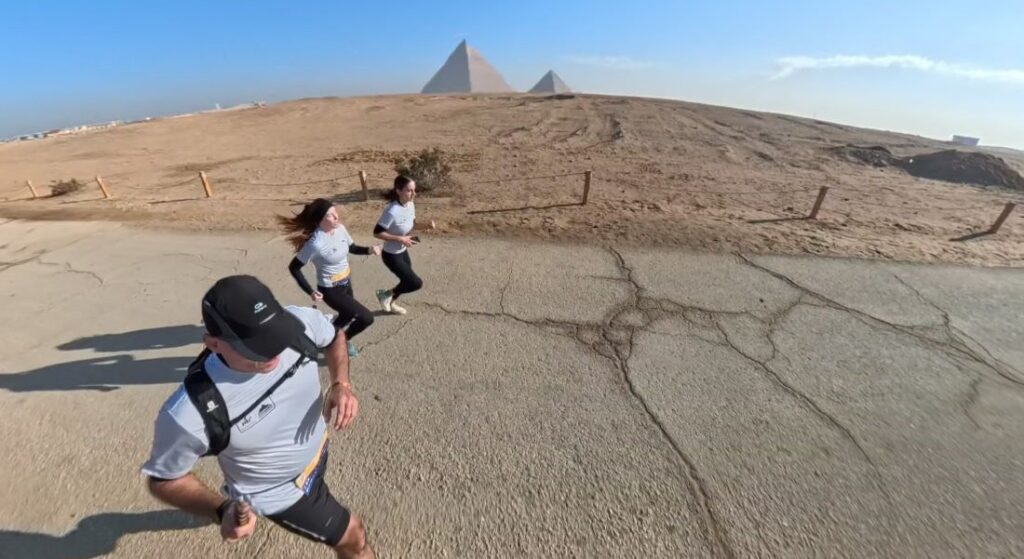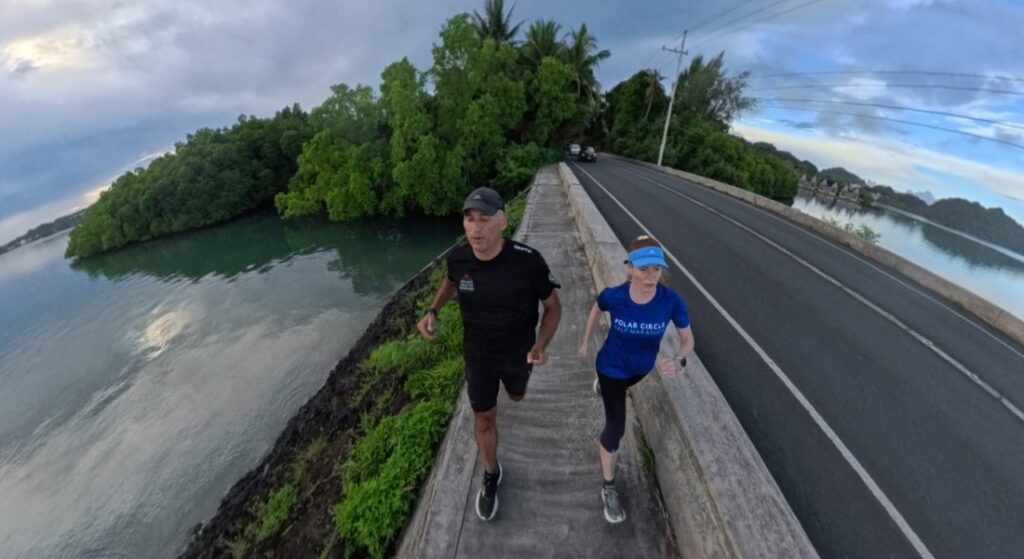King George Island, Antarctica. March 2023
Overcoming the fearsome currents of the Drake Passage and facing gusts of battering wind, we ran at the far end of the world. In Antarctica! A land of magical glaciers and colonies of penguins leaping in ice-dappled waters.
🌍 The trip 📷
Buenos Aires
Men wanted for hazardous journey. Low wages, bitter cold, long hours of complete darkness. Safe return doubtful. Honour and recognition in event of success.
Advertisement in “The times” for Ernest H. Shackleton expedition of 1913
These words, published by Ernest Shackleton in an advertisment in the “The times” in 1913, were shown to us in the “welcome” dinner in Buenos Aires…
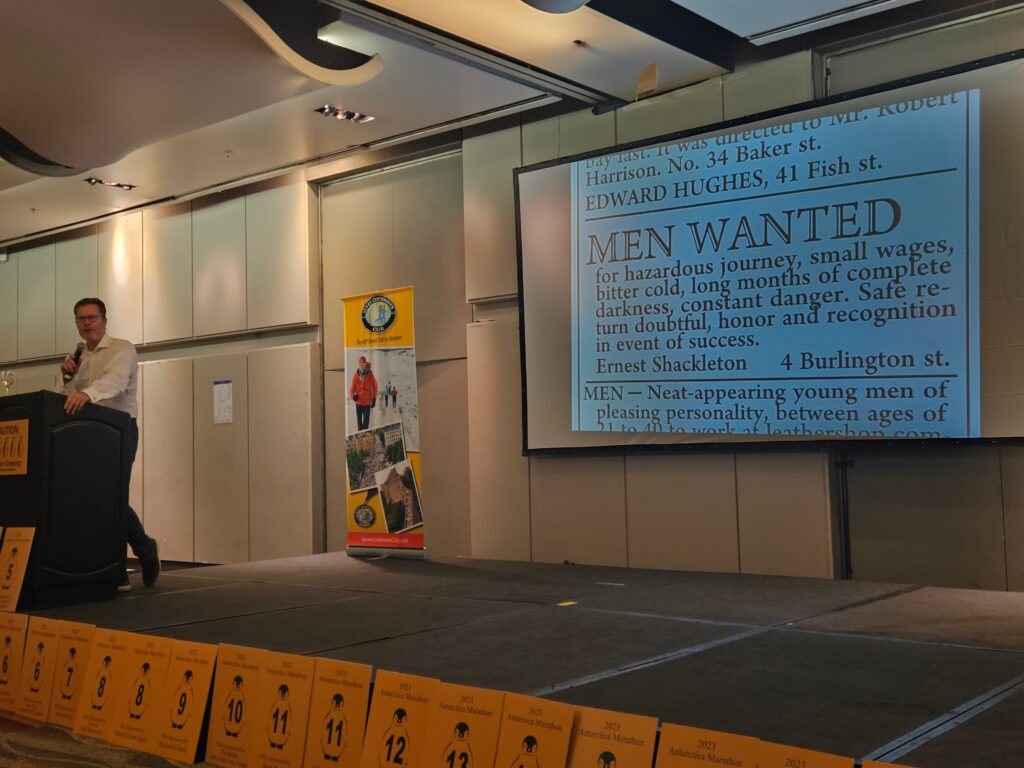
Soon we realised that most of the participants in this trip were experienced runners. The event is not just popular for those who pursue the challenge of running a marathon on every continent (“7 continents club“). It is also popular for those who “collect” marathons like others collect stamps. When the race director, Jeff Adams, asked if there was anyone among us who had run more than 50 marathons, several people raised their hands. As if it were an auction, Jeff went up in number “100, 150, 200? more?” until a guy confessed that he had ran more than 400!
I was also here because of my passion for running. Although my real motive was the longing for adventure. Something I have had since I was a child, when reading Stevenson or Verne.
In our times of digital nomadism and instagram tourism, there are few places on Earth where you can experience a sense of remoteness.
Antarctica is one.
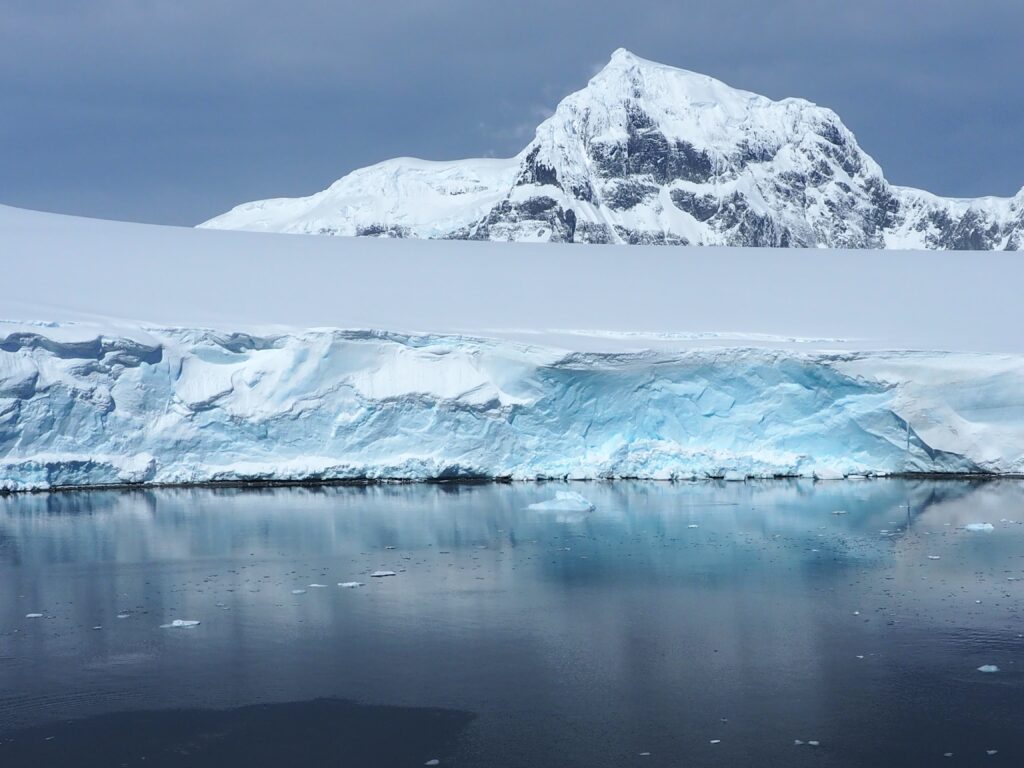
Ushuaia
We arrived in Ushuaia, in the southernmost tip of the American continent, flying from Buenos Aires.
In Buenos Aires, a heat wave would have us doing our last tappering runs at almost 40℃/104°F. But we were not discouraged by it, and we did squeeze in a couple of runs, that I will write about in a post dedicated to “running in Buenos Aires”.
We noticed a big contrast when getting off the plane in Ushuaia. Not only because of the low temperature, but also because of the snowy Martial mountains, impressive guardians of the enclave:
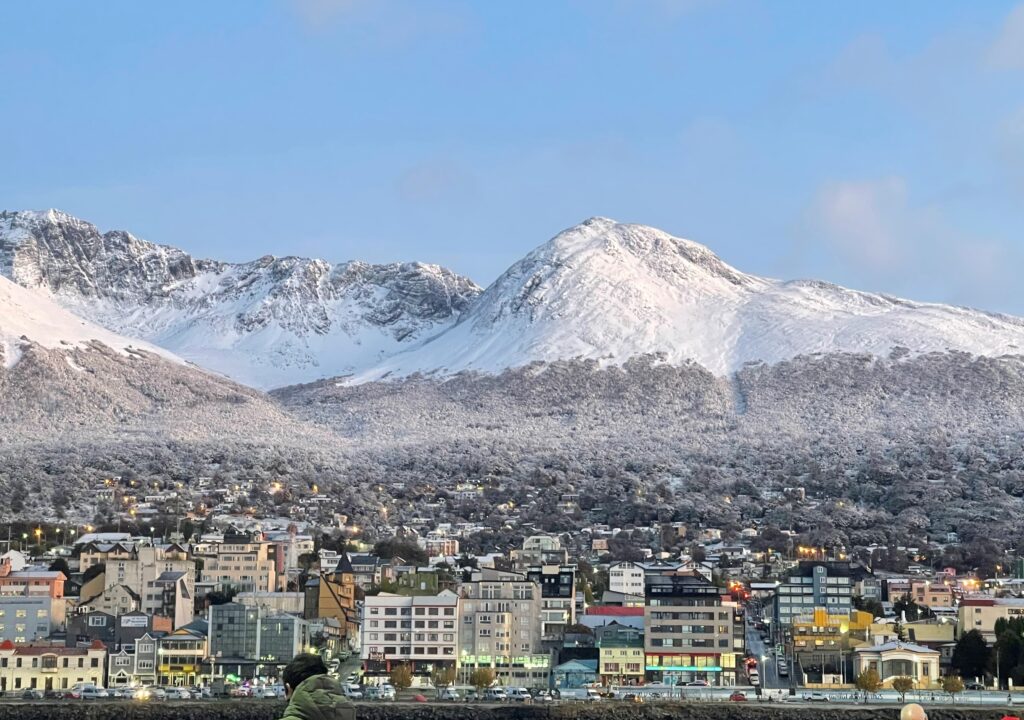
Ushuaia is a city with colorful facades and a “tradition of men on the run”, as Javier Reverte mentions in his wonderful book “Confines”. Ushuaia was born as a prison, and is now decorated with murals on the fortitude of spirit of the Yaman Indians.
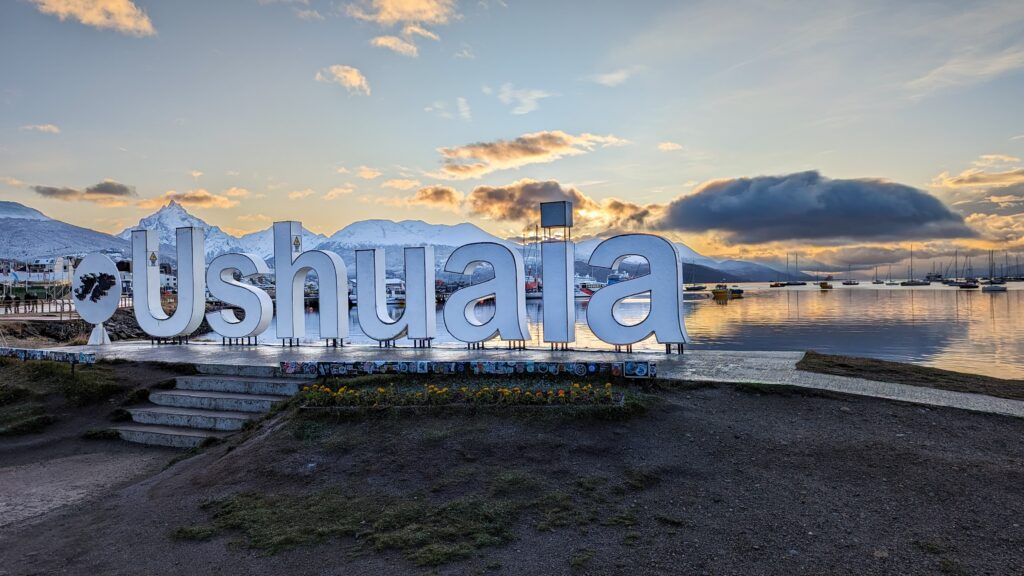
The Beagle Channel
There are several ways to run a marathon on the Antarctic continent. We chose to arrive crossing the Drake Passage, with the tour organised by Marathon Tours and Travel.
We were very lucky, because we boarded a brand new and comfortable ship:
The Ocean Victory!

The ship even has Rolls Royce stabilizers to mitigate the effect of the currents. In previous years, the ship was an old Russian icebreaker.
Some still tell the tale of the year 2002 when, due to bad weather, participants had to run the marathon around the deck. They had to complete more than four hundred laps!
Here’s another picture where this beauty of a ship can be observed:
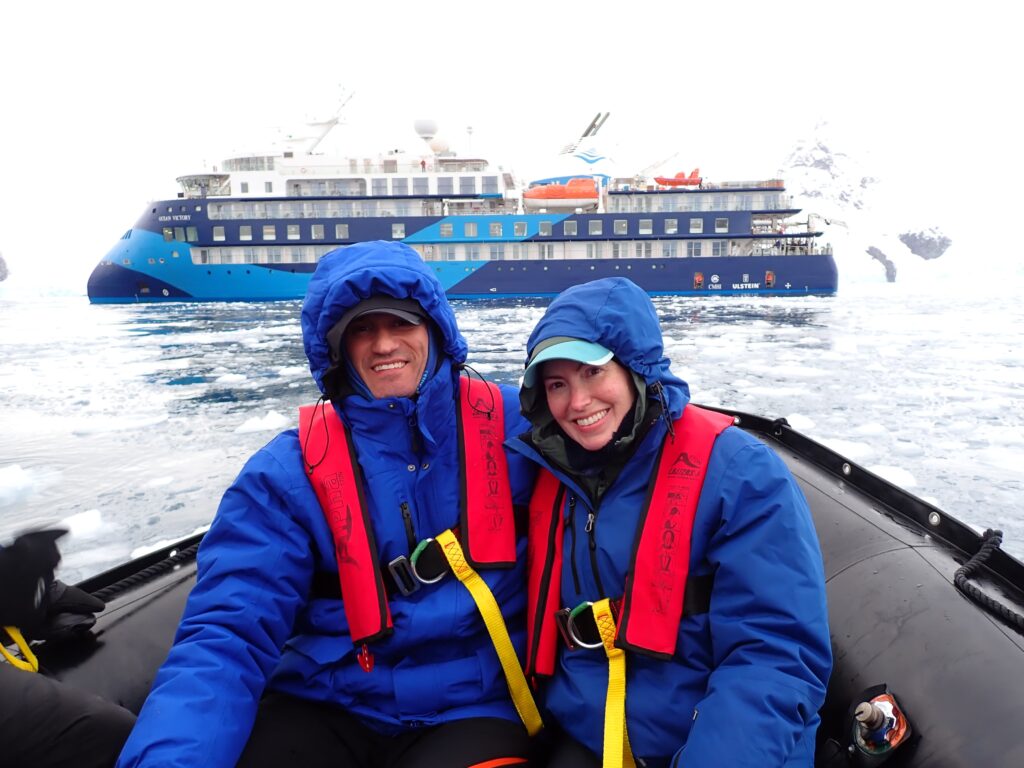
But… after departing Ushuaia, waves more than 9 meters high were hitting the Drake Passage. They made the Ocean’s Victory captain decide to spend the night anchored in the Beagle channel. The channel takes its name from HMS Beagle, the ship on which Charles Darwin traveled.
In fact, all the toponymy of the area refers to the exploits of past centuries, with a hodgepodge of heroes or villains. Explorers, fortune seekers, scientists and pirates. On the map you can read names like Magellan, Darwin or Drake. Although the real name of the passage is that of Francisco de Hoces, a mariner from Cordoba, Spain.
Regarding Magellan, Stefan Zweig said in his biography Magellan: the man and his deed. “In every discovery there is a moral stimulus, a winged force of the spirit”
And, three days after, when we were about to run, I hoped that all of us could count on our own “winged forced” to finish the race.

The Drake Passage
¿The Drake Passage? Well, I guess I wanted to add another challenge to our adventure.
Since I get dizzy during a ride on “la Golondrina” in the calm waters of the port of Barcelona, I decided to cross the fearsome Drake Passage. And I did. Although the level of sea sickness pills that I put in my blood could well count as “doping”.
The journey at sea lasts for two days, but luckily the Ocean Victory has nice restaurants, comfortable lounges and even a jacuzzi!

Although, at times, it gets messy, with the high waves. A lot of people were going around with sickness patches behind their ears. The expedition doctor had to even publicy warn people not to wear 2 patches! Apparently, some runners were looking to make their trip more “amazing” …
We arrive to Antarctica
After cruising for more than two days where the two largest oceans meet, we crossed latitude 60 south and entered Antarctica. And I really felt that I was in remote lands then.

Just after our ship anchored in Mikkelsen Harbour. We were in the confines of the Earth.
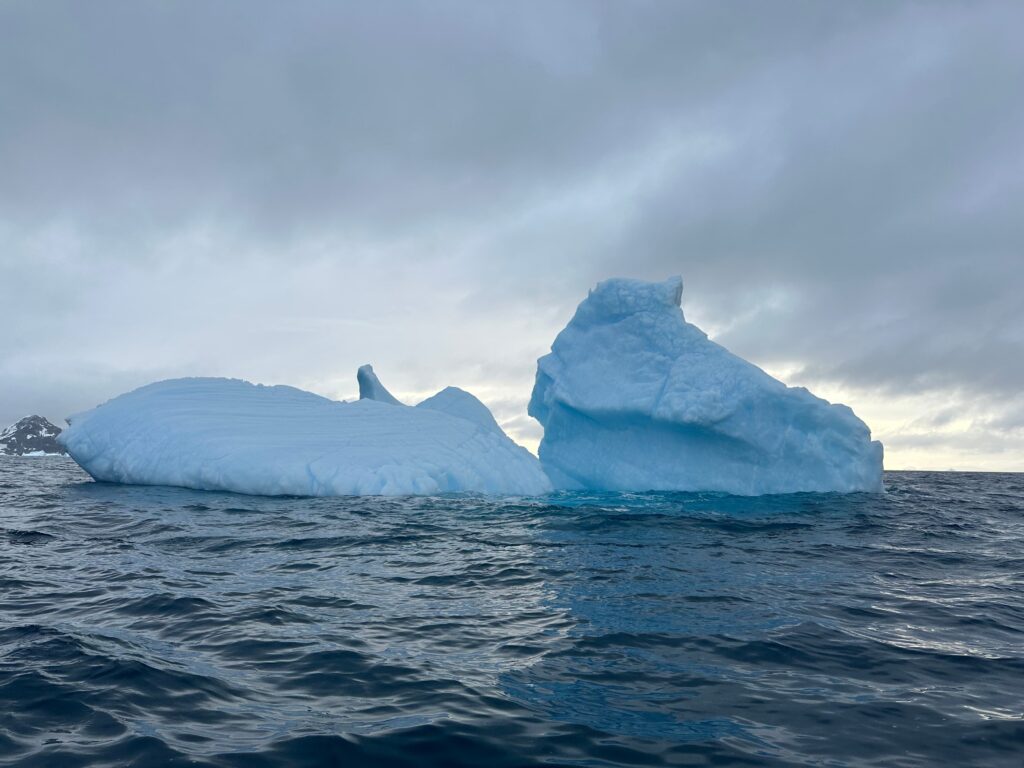
Then we sailed to King George Island, populated only by a handful of scientific bases (and penguins!). Although the Russians have opened a souvenir shop at their Bellinghausen base.
Ironically, it’s the former Soviets who monetize the willingness to buy of the few visitors. They sell t-shirts, fridge magnets or penguin souvenirs.
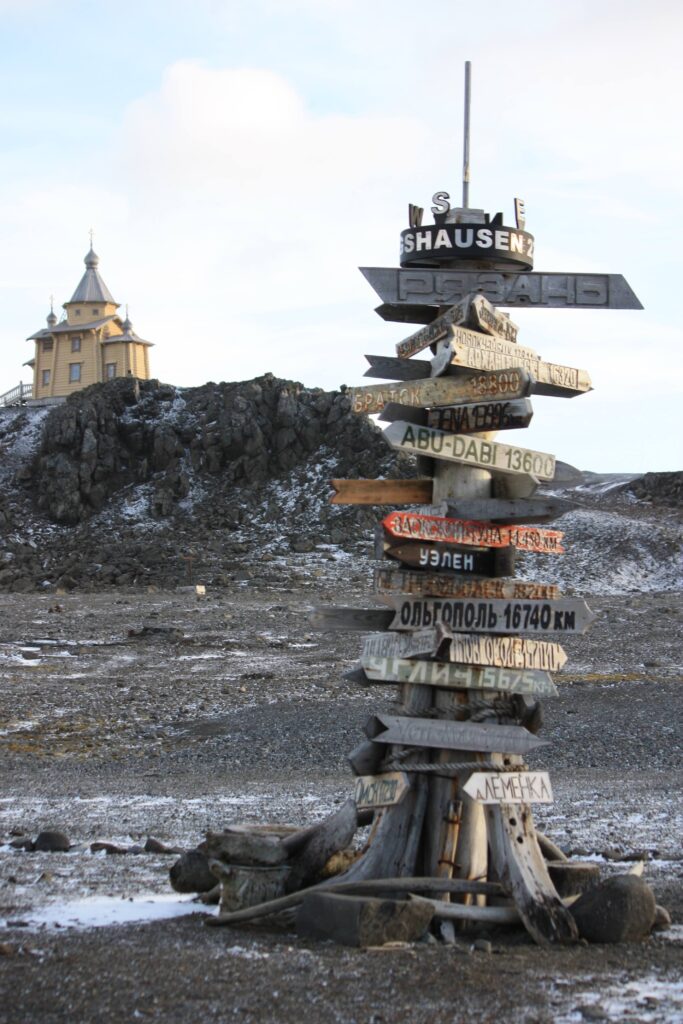
The Bellinghausen base also has a church, the Holy Trinity Church, one of the eigh churches on Antarctica, and the southernmost Eastern Orthodox one.

Also here, in this base, one of the few crimes in Antarctica happened. In 2018, a Russian engineer attacked one colleague with a knife, wounding him badly.
🏃♀️ The race 🏃♂️
Before
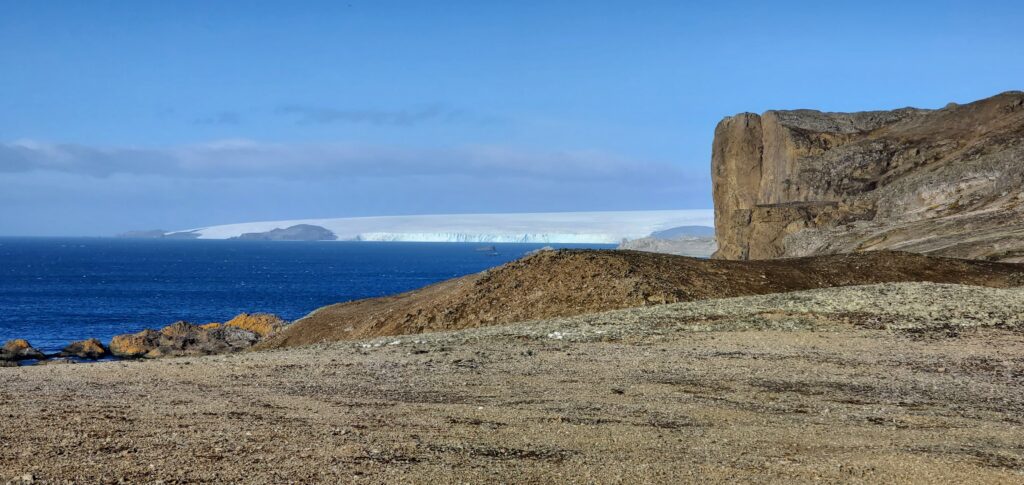
Upon anchoring, the winds of almost 40 knots (more than 74 kilometers per hour) made the organization to postpone the race, and divide it into two different race in two consecutive days.
Having to wait increased the anxiety of some runner, who did not take the “forced” tapering well. Pre-race anxiety was increasing exponentially. The smiles became more tense, the camaraderie more forced, and some hit the cocktails bar 🍸. Reasoning that they had been given one more day to spare, I guess 😉. In some cases, trip-end bills would end up being more painful than post-race lactic acid.

Once on King George Island we didn’t have to deal with the alien that the scientists in the movie “The Thing” face.
But we did face very adverse conditions.
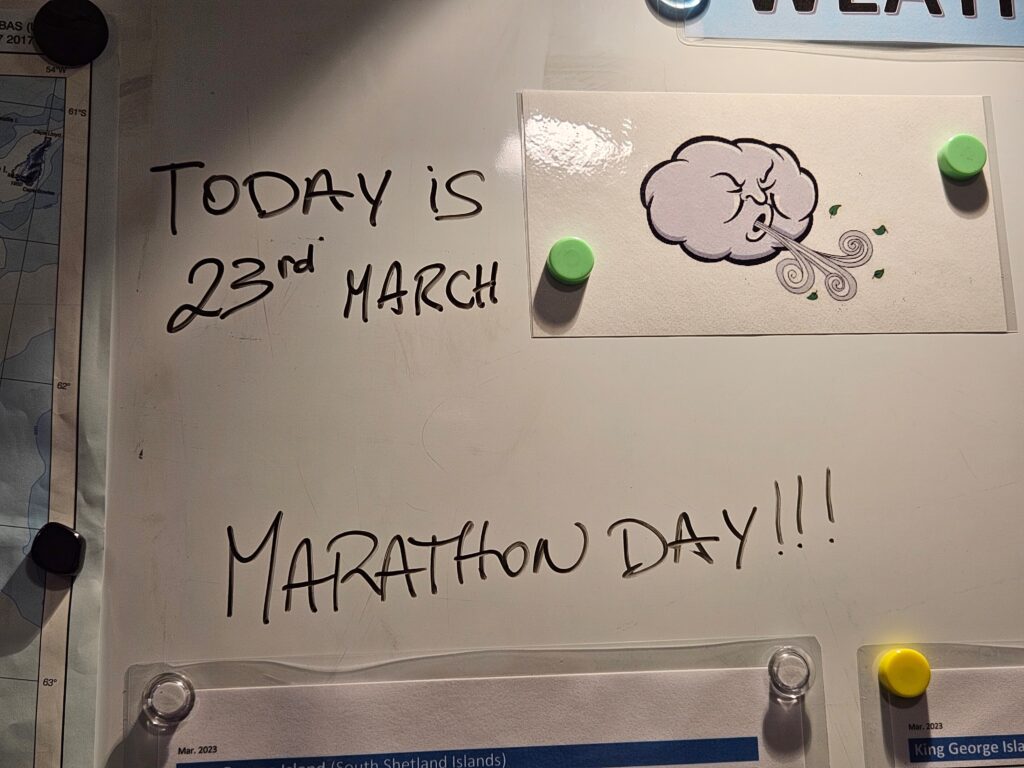
Not only those due to nature. But those dictated by the current treaties and restrictions to preserve the precarious natural balance of Antarctica. Our clothing was checked for possible contamination, the individual bottles we carried for hydration were closely monitored, and we were urged not to leave behind any type of human waste while running.
Without going into details, I will mention that we were urged over the public address system during the previous hours to “control fluid intake” …
The race

First kilometers
The race is difficult, and some even give up, discouraged.
In 2023, the year we ran, the route consisted in several 7-odd-kilometre laps along one of the only tracks that exist on the continent. Three laps for the half marathoners, and six for the marathoners.
The track starts in the Russian Bellinghausen base (the one with the knife stabbing incident 😅) and goest to the Uruguayan Artigas and back.

The first day we still saw the sun; the second day riders dealt with dreary steely skies and persistent rain.
In the route you find endless hills with treacherous patches of ice, streams of water that turn into rivers after a few hours, and zones that are authentic morasses.
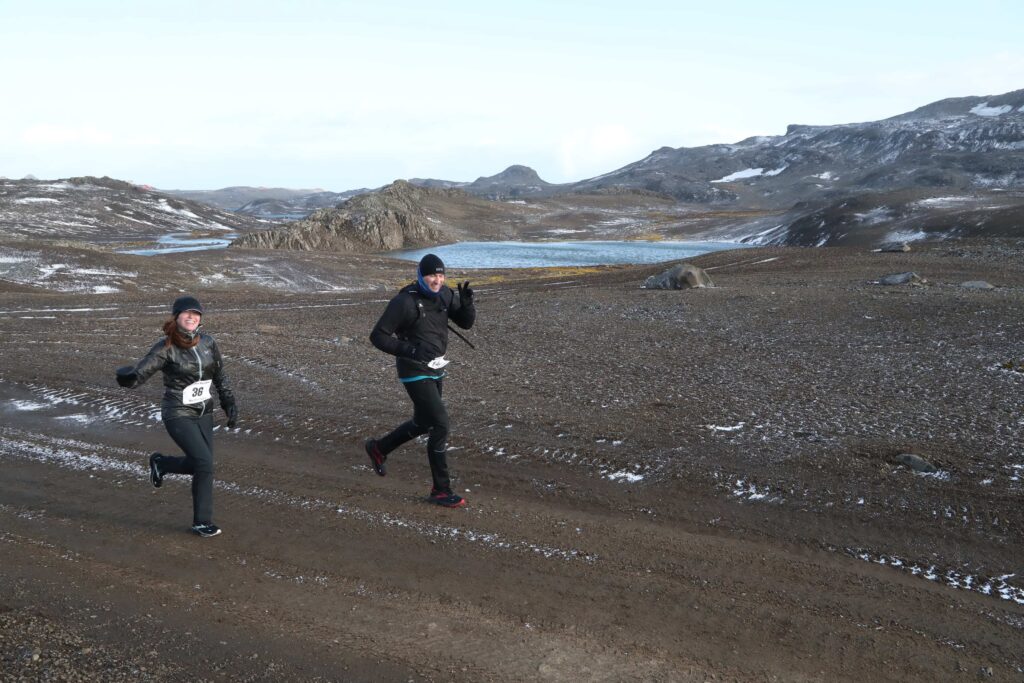
Ironically, the mud adhered to the shoes is one of the best souvenirs that you can take from Antarctic lands. After a few days, you can scratch the remains of the race while reminiscing about the “feat”.
And in the bay, where the departure and arrival point had been installed, a few penguins seemed to look curiously at the group of crazy runners who were circling up and down the coasts that are their home.

Final part
Not in vain, the organization had warned us of these nice spectators with some posters of “Penguin Crossing”.

We ran the half marathon, and the “prudent” distance allowed me to enjoy the race. At certain moments I allowed myself to look up. Something I should not advise to do, since you better look very carefully where you were stepping…
I treated myself to some strange moments of communion with the place. The eternal ice of Antarctica could be seen behind the hills of dark rock, only dotted with the color of yellowish mushrooms and lakes with turquoise waters.
And I was lucky enough to finish as the first female runner of the day, something I was not expecting and that filled me with joy:
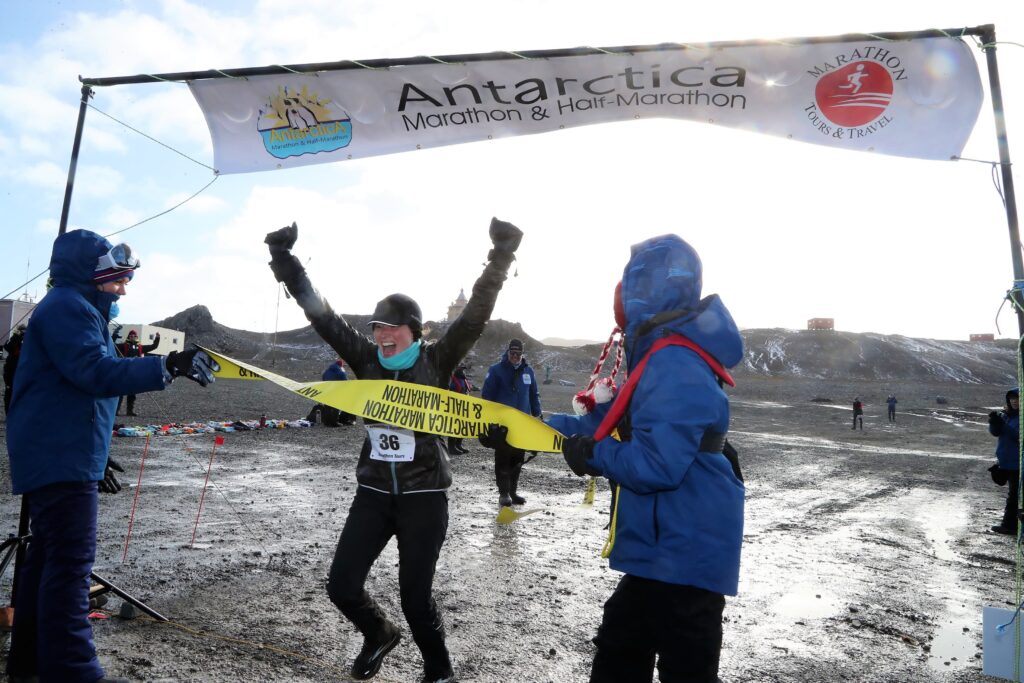

After the race…
After the race, as if we didn’t have enough adventure 😜, the cruise offered the opportunity to take a dip in the frigid waters of the Antarctic Ocean:


At 2℃/35.6°F, the experience resembles a very painful acupuncture, boosted by the adrenaline rush and topped off by a shot of alcohol!
The following days you get the see the most wonderful places on Earth.
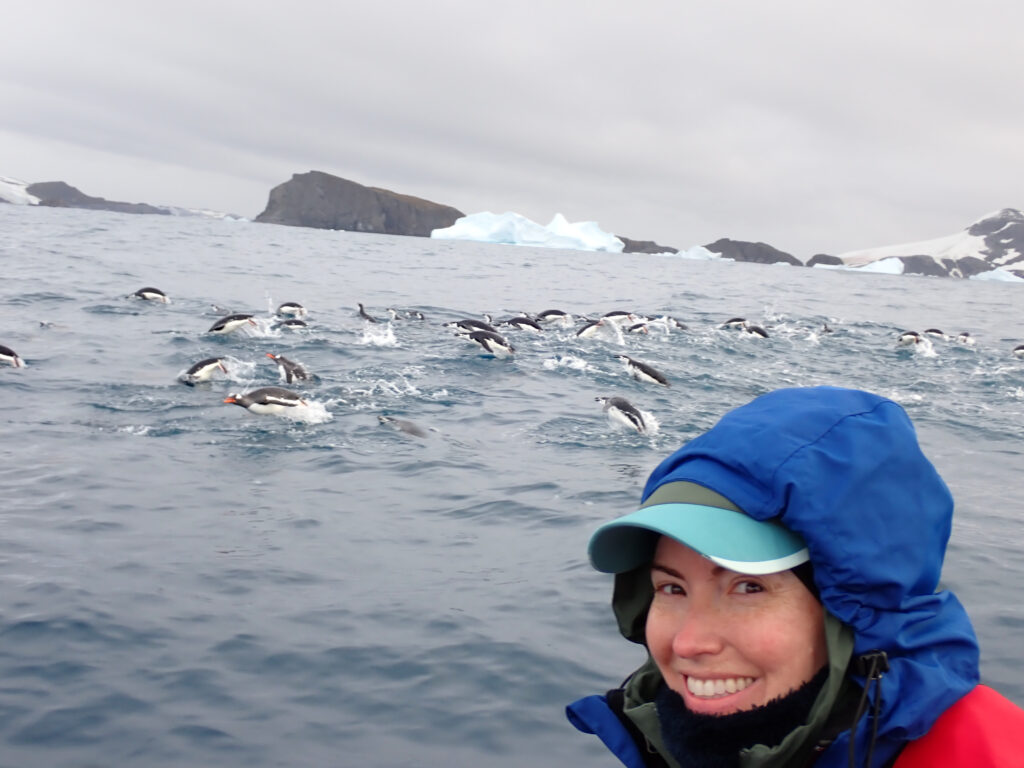
You also set foot on the continent in Sierra Cove, where I could even attempted to do some yoga…
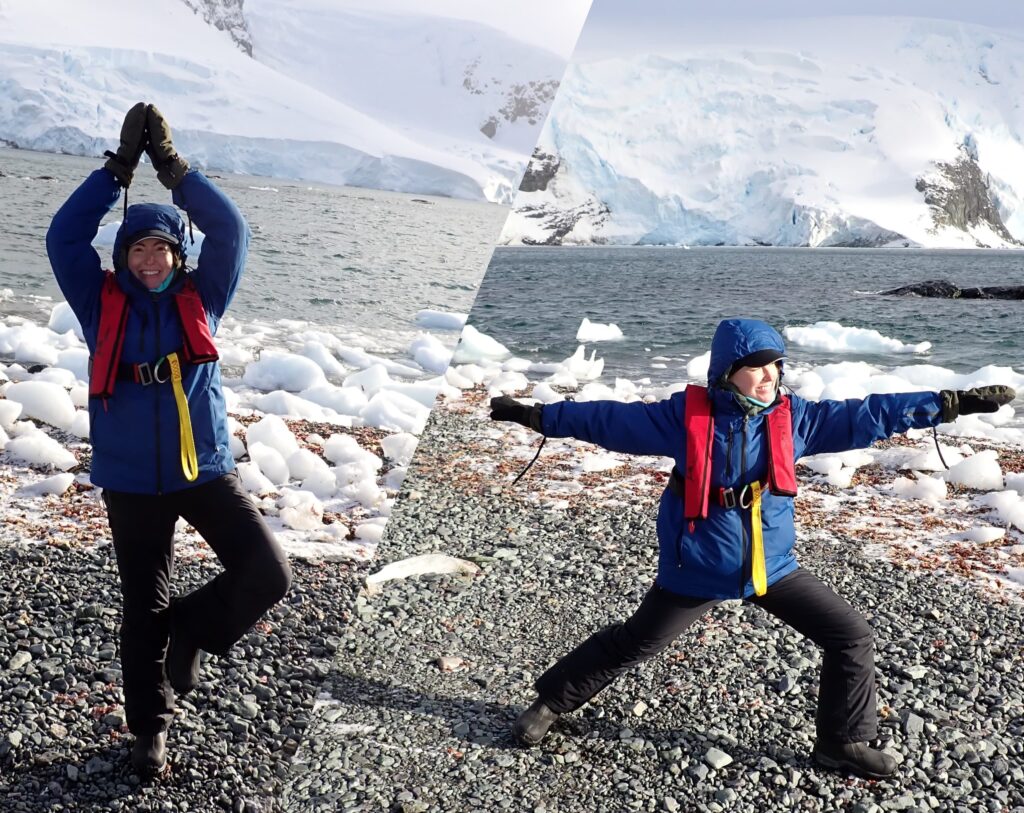
One of the highlights of the trip is when you get to ride with zodiacs in the wonderful Mikkelsen bay, where we “fished” a piece of ice that was a thousand years old! Thanks to it, that night some of our colleagues enjoyed a whiskey with ancient ice cubes!

In summary: the Antarctic marathon is a wonderful experience.
Despite the cold, the discomfort, and the obstacles posed by the wind and muddy tracks.
The honor and recognition that Shackleton’s men sought a hundred years ago is now given, not so much by a medal, but by the pride of crossing the finish line in a land guarded by endless glaciers.

Useful information
🏆 Antarctica Marathon (42K) / Half Marathon (21K) First edition: 1977. Number of runners: Limit to 100 per race. Cut-off time: 6h 30m for the full marathon.
⛰️ Difficulty Very high. Subzero temperatures, hilly and with strong gusts of wind.
🌐 Website https://www.marathontours.com/
🗓️ In February/March. You run between the Russian base Bellinghausen and the Uruguayan base Artigas on King George Island, one of the only areas of the entire continent that is not covered by ice.
👟 Although, unlike other ice races, spikes are not necessary, it is important to be equipped not only with the logical thermal clothing, but also with outer layers that act as windbreakers and, if possible, waterproof Goretex shoes. Read here the post about running gear for cold climates.
🏅 You will get home with a very nice medal and a long-sleeved event jersey (of questionable design). You can take home the jackets they provide you for going ashore and zodiac excursions.
Pros and cons
✅ Ideal for those who want to complete a marathon (and/or a half) on each continent.
✅ Very well organized, with all the details taken care of and a special focus for runners. Travelling to the Antarctic Peninsula is an unforgettable experience, due to its impressive landscapes and its wild fauna.
❌ Very expensive: not only because of the package, but also to buy the necessary equipment to run (if you do not have it) and the international flights, which are not included.
❌ Navigating Drake’s Passage will put your stomach to the test, and there is a “forced” tapering of several days. Running on the deck in open water is not allowed (for obvious reasons to those who have sailed in such latitudes) and the Ocean Victory gym only has a precarious treadmill. The race is hard, the weather conditions will not make it easy for you, and there is a risk of not finishing it in the six and a half hour limit set by the organization.

Map


One book
“Who goes there?”, by John W. Campbell
The book that inspired the movie “The thing” is short, super sharp and at points terryfing.
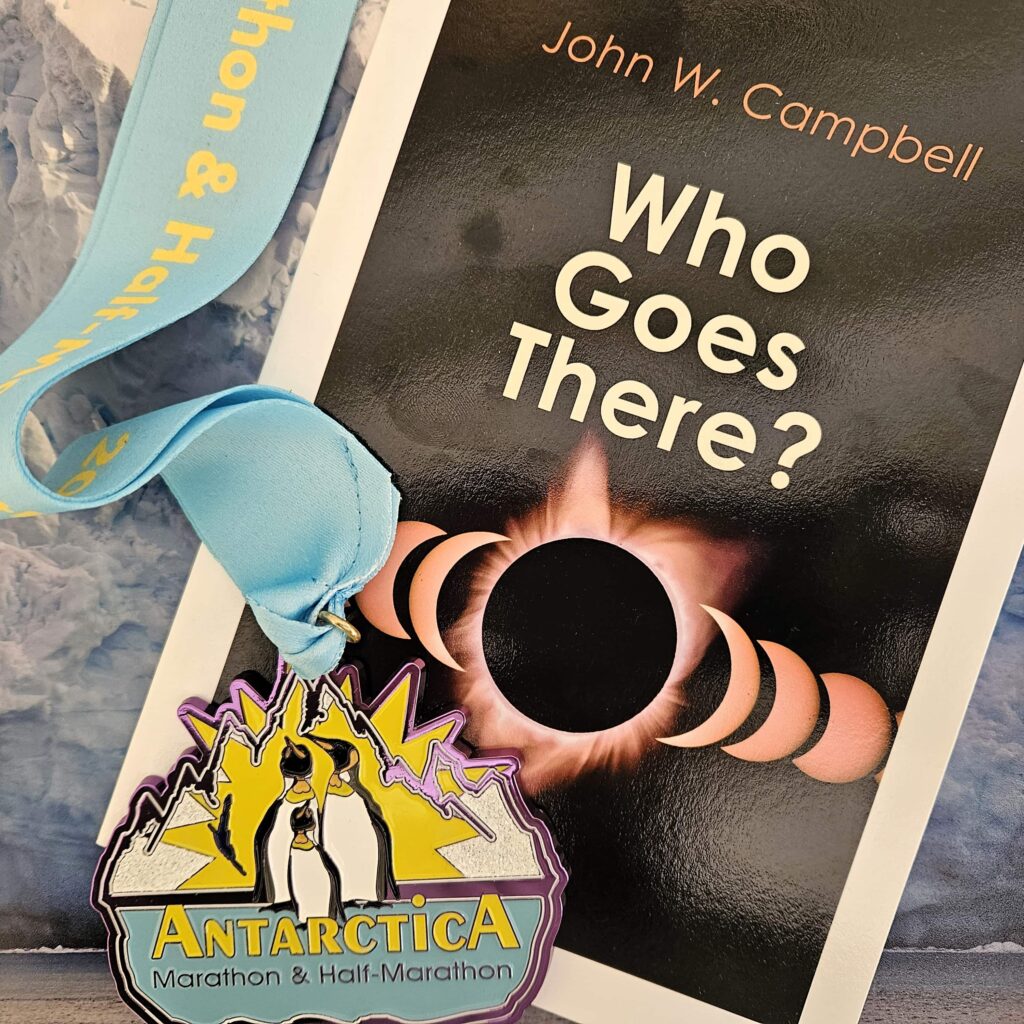
Summary: The novella that formed the basis of “The Thing” is the John W. Campbell classic about an antarctic research camp that discovers and thaws the ancient, frozen body of a crash-landed alien. The creature revives with terrifying results, shape-shifting to assume the exact form of animal and man, alike. Paranoia ensues as a band of frightened men work to discern friend from foe, and destroy the menace before it challenges all of humanity!

To know more…
We drank yellow water, putrid for a long time, and we ate the ox skins that are on the mainmast to prevent the rigging from being damaged…. Many times we had to eat the sawdust from the wood….
Antonio de Pigafetta, chronicler of the Magellan expedition (1519-1522)
| 📖 “Madhouse at the end of the world”,by Julian Stanton 📖 “Endurance”, by Alfred Lasing 🎬 “The thing”, 1982. 📖 “Scott and Amundsen”, by Roland Hundfort 📖 “Confines”, by Javier Reverte (only in Spanish) |
If running seems difficult to you, reading the story of Magellan’s expedition sets you straight.
“Endurance”, by Alfred Lasing
Among the abundant bibliography dedicated to the epic of Ernest Shackelton’s “Endurance”, I decided to read Alfred Lasing’s classic, which recounts how the ship ran aground on an ice pack in the Weddel Sea in 1907 and the entire crew survived for more than two years.
⭐⭐⭐⭐
“Madhouse at the end of the world”, by Julian Sancton
Thanks to the conferences that were given at the Ocean Victory, I discovered the magnificent “Madhouse at the end of the world”, by Julian Sancton, halfway between a black thriller and a very white horror film, which recounts how a 1902 Belgian expedition went very, very wrong (with a young Amundsen as a supporting actor).
⭐⭐⭐⭐
“Scott and Amundsen”, by Roland Hundfort
To relive the famous duel between Amundsen and the ill-fated Scott, I chose “Scott and Amundsen” by Roland Hundfort. It is a very extensive and well documented book, that nonetheless keeps the attention of the reader. What an amazing tale!
⭐⭐⭐⭐


